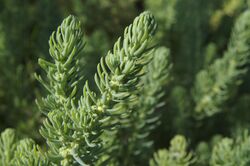Biology:Suaeda californica
| Suaeda californica | |
|---|---|

| |
| Scientific classification | |
| Kingdom: | Plantae |
| Clade: | Tracheophytes |
| Clade: | Angiosperms |
| Clade: | Eudicots |
| Order: | Caryophyllales |
| Family: | Amaranthaceae |
| Genus: | Suaeda |
| Species: | S. californica
|
| Binomial name | |
| Suaeda californica S.Watson
| |
| Synonyms | |
|
Suaeda americana | |
Suaeda californica is a rare species of flowering plant in the amaranth family known by the common name California seablite.[1] It is now endemic to San Luis Obispo County, California, where it is known from a few occurrences in the marshes around Morro Bay, historical populations around San Francisco Bay have been extirpated.[2]
Description
Suaeda californica is a mound-shaped shrub up to 80 centimeters tall with hairless or slightly hairy succulent green or red-tinged herbage. The woody stems have many branches which are covered with the knoblike bases of old leaves. Between these grow the new leaves, which are lance-shaped and up to 3.5 centimeters long. The flowers occur between the leaves, all along the stems. Each cluster has 1 to 5 flowers and is accompanied by a leaflike bract. The calyx is a cone of fleshy, rounded sepals, and there are no petals. The fruit is an utricle that grows within the calyx.
Habitat
This rare plant, Suaeda californica, grows in a restricted area within the intertidal zone of salt marshes.[3] It is threatened by anything that alters the hydrology of the area, such as changes in sedimentation, including dredging, erosion, and recreation.[2] It requires a porous substrate high in nitrogen, which may come from decaying plant matter and bird droppings.[4] Invasive plant species such as introduced ice plant threaten remaining occurrences and reintroductions.[4]
Endangered status
It once occurred around the San Francisco Bay, but any populations there are now extirpated.[2] It probably once grew along the Petaluma River north of the bay, as remains of the species have been found in adobe bricks there.[5] By 1991 the total remaining number of individuals was estimated to be below 500, and the plant was federally listed as an endangered species of the United States in 1994.[2][3] Some carefully tended populations have been planted as reintroductions at locations around the San Francisco Bay.[4][6]
References
- ↑ "Suaeda californica". Natural Resources Conservation Service PLANTS Database. USDA. https://plants.usda.gov/core/profile?symbol=SUCA. Retrieved 4 December 2015.
- ↑ 2.0 2.1 2.2 2.3 The Nature Conservancy
- ↑ 3.0 3.1 USFWS. Endangered or threatened status for five plants and the Morro shoulderband snail from western San Luis Obispo County, California. Federal Register 59:240 December 15, 1994.
- ↑ 4.0 4.1 4.2 Eaton, J. and R. Sullivan. Recovery plan for endangered seablite. San Francisco Chronicle March 21, 2010.
- ↑ California Native Plant Society Rare Plant Profile
- ↑ Audubon Society
External links
- Jepson Manual Treatment - Suaeda californica
- Flora of North America; Suaeda californica
- Suaeda californica - Photo gallery
Wikidata ☰ Q7630447 entry
 |

